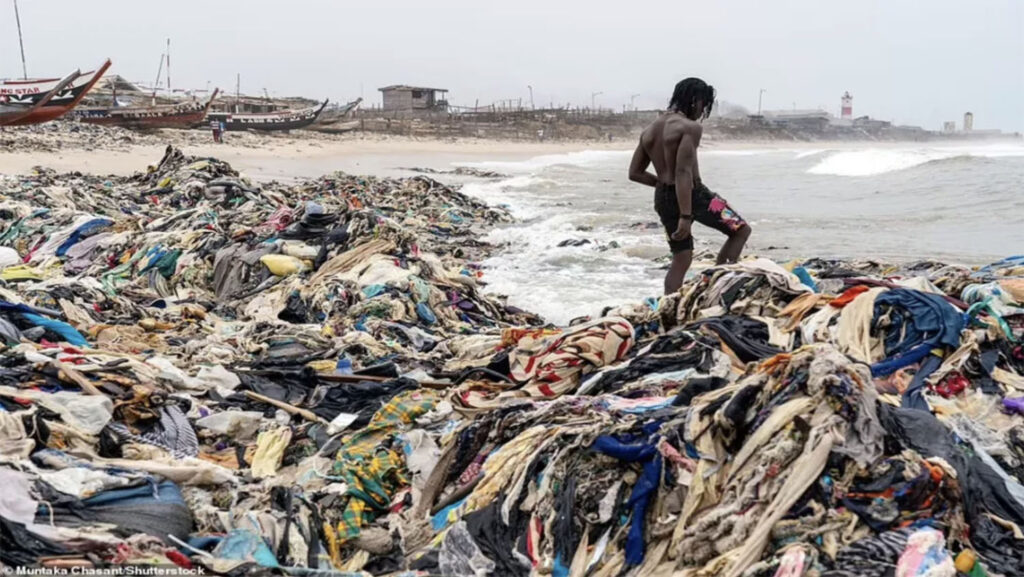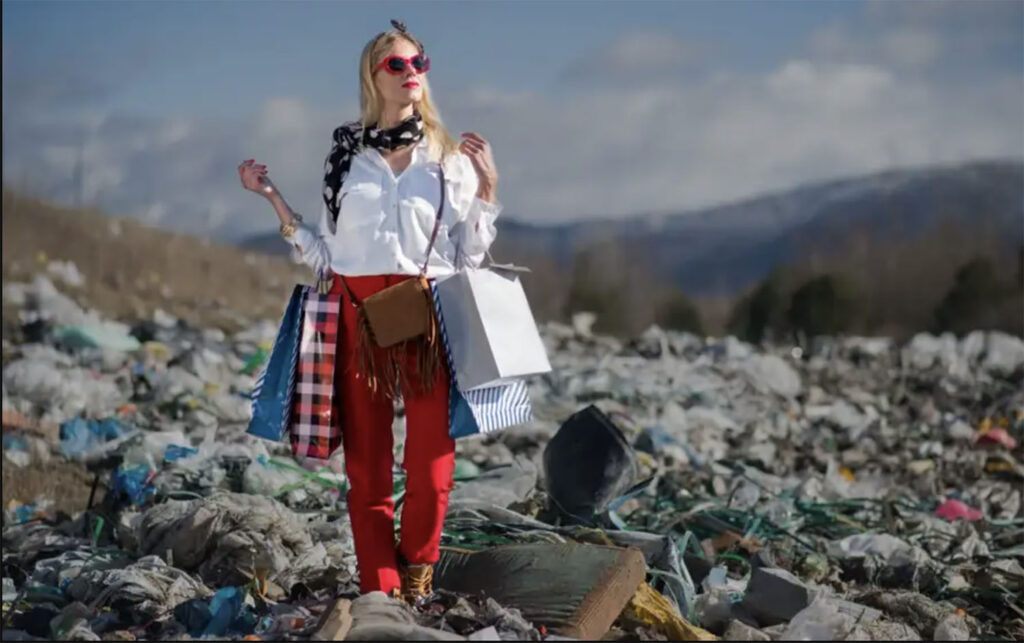By Alexandra Greer, Alliance Intern from Fordham University ‘25
I used to think my cousin was the coolest because she had the cutest clothes. Then I remember going to her closet and seeing mounds of clothes that dominated the small space. When I asked her what she does with the stuff she doesn’t want, she shrugged the question off. I’ve carried that experience with me, seeing the messy truth behind her stylish pairings. Since then I’ve always been careful to think more about my clothes. In fact, few of us actually think through the impact of our clothing choices on the environment and people.
Thus, I began a journey to discover where my clothes come from and go when I’m done with them. I was shocked to find that the fashion industry produces a whopping 100 billion articles of clothing a year and upwards of 90 billion tons are deposited into landfills all over the world, mainly in Africa, according to the Round-Up. I’ve learned more than I’d bargained for. It has changed how I see my clothes. These findings have led me to seek clothing that I love and is more affordable in a way that doesn’t devastate people and the planet.
My Awareness of Fast Fashion Addiction and Over-Consumption
For a long time I equated trendy styles with over-consumption. My own friends spent the little money they had on a popular style they’d seen online. But these fads were changing faster than their bank accounts could catch up, and the prices were increasing even more rapidly. And as clothes were turned out so quickly, I wondered where they were sent after not being purchased from the store.
I tried my best not to buy something just because everyone else was, but I was conflicted. As I admired racks of clothes and dreamed of a killer wardrobe, I didn’t want to be part of such an addictive, consumptive lifestyle. And I would never consider throwing out clothes in good condition.
Corporate Greed Breeds Horrific Labor Conditions and $1/hour Pay
These concerns grew within me as I saw more and more companies exposed for their unethical, inhumane practices. These include everything from excessive and forced overtime to withholding wages, child-labor and limited freedom of movement, according to the Clean Clothes Campaign. The companies seek to present a fashionable facade to keep consumers blindly ignorant of their offenses, so we continue to buy products with clean consciences.
The global nonprofit Fashion Revolution‘s Fashion Transparency Index evaluates the policies of 250 of the world’s largest clothing companies on their company policies. Only 28% of companies publish data relating to modern slavery practices. The majority of companies are not reporting on the safety of their work environments, so malpractices are going unnoticed and workers are suffering in silence.
When choosing to buy from name brand stores, I recognize I’m buying from factories and manufacturers in developing countries who rely on these irresponsible practices. What’s even worse, only 1% of these companies report the number of employees who are being paid a livable wage, according to the FTI. It’s common for these employees to work 96 hours a week just to make enough money to eat,SustainYourStyle points out. If they worked any less, they would likely be fired. And according to them, the average worker in Chinese factories makes $189/month.
Business Insider reported on an undercover investigation found that “workers at factories in China that supply clothes to massive fast clothing manufacturer Shein frequently work up to 18 hours a day with no weekends and just one day off per month.” At one factory, workers get a base salary of roughly $556 per month to make at least 500 pieces of clothing per day with a commission of just two cents per item. That means their base pay is only $1.06/hour if they work 18 hrs/day x 29 days/mo = 522 hours/month.
At another factory, workers don’t have base pay but receive just under 4 cents for each garment they make. “Employees are hit with a fine amounting to two-thirds of their daily wages if they make even one mistake,” according to the report.
Reports have shown that Zara uses a supplier whose warehouse has ‘slave-like conditions’, employees in H&M factories continuously undergo human rights violations, and Victoria’s Secret employs child-labor. Other brands have similarly been exposed for extreme negligence, and are also notorious for sending their unsold articles to landfills all over the world.
60% of Our Clothing is Plastic! And the Health Effects on Workers
These same factories manufacture clothes out of cheap synthetic fibers made from petroleum, almost 60% of which are plastic.
Employees are thus exposed to harsh chemicals used in production and are subject to inhaling fiber dust. Health effects are worsened because factory buildings often have no ventilation or even windows, so people are suffocating in hot, stuffy, poisoned air.
85% of All Textiles End Up in Landfills
Name brands and large department stores also massively contribute to large-scale global waste. In America alone, an estimated 11.3 million tons of textile waste – equivalent to 85% of all textiles – end up in landfills on a yearly basis, according to the EPA. About 80% of materials used in textile production are wasted. This doesn’t account for millions of tons that are burned, creating further waste and pollution. And with only 1% of clothes upcycled into new garments, we are contributing to a behemoth of forgotten and unwanted cloth.
Since clothes made from cheaper materials aren’t as durable as pure cotton or silk, it forces consumers to buy clothes more frequently. All of these and more are tactics used to increase profits for these large corporations while workers are left to suffer, and buyers are unknowingly contributing to these corporate crimes against people and the environment.
I now recognize that if I purchase their products I’m a participant in a system leading to overstocking, waste of materials that could serve so many purposes and abuse of workers and the environment.
Opting Out of Mainstream Clothing Consumption and Embrace a New Ecosystem
And while some consumers have committed to not buying their products, such as the Shut Down Shein campaign, it hasn’t been enough for these companies to change their practices. This is why I opt out of this linear exchange of materials where everything ends up in a dump, where clothes go to die. I choose to consume within an entirely different clothing ecosystem that does not directly involve mega clothing companies.
There is an entirely new way of thinking and consuming textiles. I shop second hand from places like Goodwill, Salvation Army, and local thrift stores. With a thorough cleaning, these clothes are as good as new. This is also a great way to develop a personal style that isn’t dictated by online trends. Shopping from thrift stores has given me the liberty to build a wardrobe based on my personal tastes and what looks best on me, not just something I saw online. These stores also tend to be more affordable.
I also take care to limit how many clothes I keep in my wardrobe. If I haven’t worn something for more than 6 months, it’s time to share it with someone who will value it as much as I did. That way I don’t end up like my cousin, with no regard for my clothes. As soon as I see them as cheap pieces of fabric instead of garments or extensions of myself, I slip into those poor consumerist tendencies.
In order for me to participate within a closed loop cycle for clothes, I refuse to throw anything away. I often give clothes to shops that resell, some of whom donate them to local charities or homeless shelters. There are a plethora of local organizations who do textile recycling and are always taking clothing donations.
I also sell clothes online through mobile apps like Mercari, Depop, Ebay, Vinted and many more. I not only make money, but feel positive that my clothes will have a longer life span.
One thing I do is to check clothing tags before making any buying decision. If I see that the material is mainly made of polyester, nylon, acrylic, or spandex, I know they are made from plastic chemical bases which shed microplastics every time the article is washed or even just worn. About 9% of microplastic in the ocean comes from clothes and other textiles. I try to stay away from those materials.
While thrifting may not be the most convenient shopping method – it takes patience and sometimes I leave the store empty handed, I feel privileged to have the choice of being particular with what I wear. With this privilege comes a responsibility, my buying habits have large implications on the livelihoods of others and the health of the planet. Where I choose to spend my money should be approached with intention and mindfulness.
It’s great to form a community to share tips and other recommendations. I’d love to hear from you about your ventures to cultivate a style you love while consuming ethically and sustainably!


